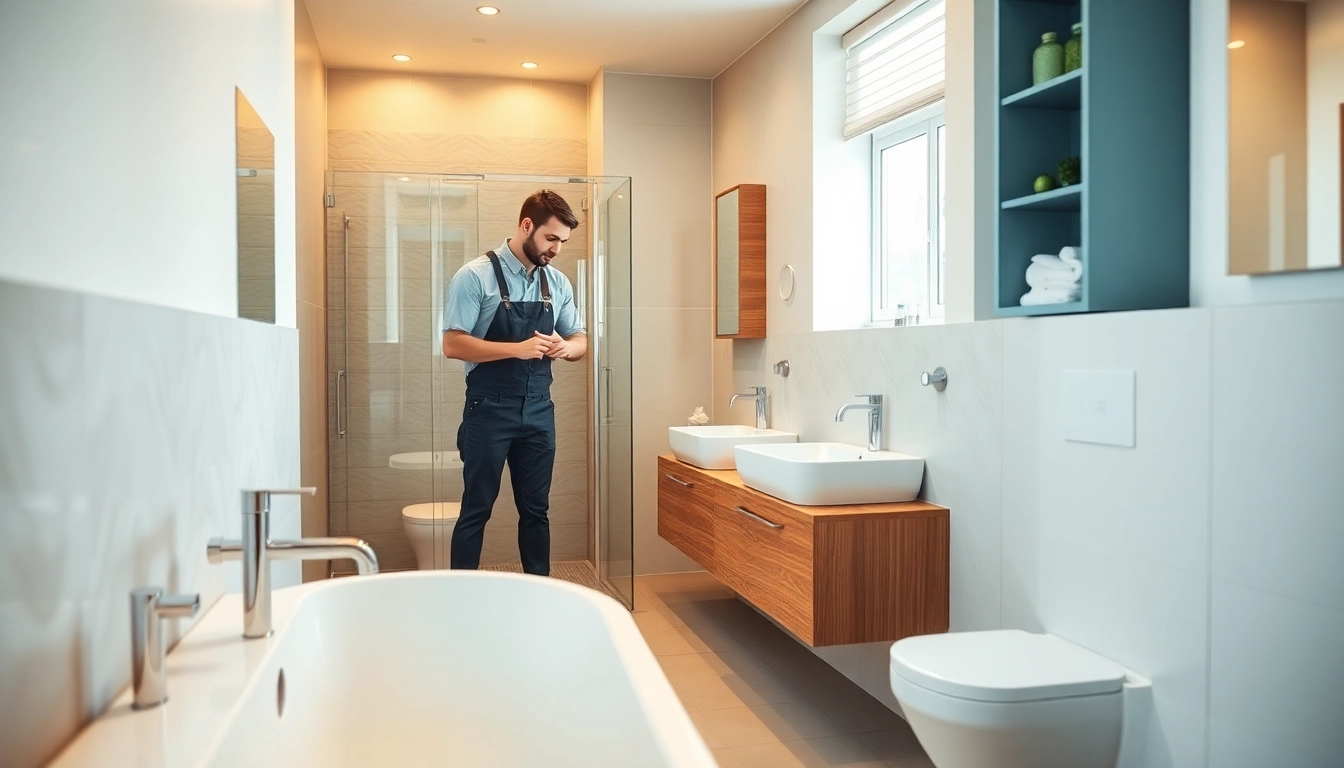Understanding Bathroom Fitters
When it comes to rejuvenating your bathroom, hiring expert Bathroom Fitters can transform your vision into reality. These professionals possess the skills and knowledge necessary to turn your outdated space into a luxurious retreat, ensuring every element fits your style and functionality needs. But what exactly does a bathroom fitter do, and how can they help you achieve your renovation dreams?
What Services Do Bathroom Fitters Provide?
Bathroom fitters offer a wide range of services tailored to the specific requirements of each project. These services include:
- Design Consultation: Collaborating with clients to create a design that aligns with their vision while considering practical aspects such as layout, plumbing, and ventilation.
- Installation of Fixtures: Installing essential bathroom fixtures such as sinks, toilets, bathtubs, and showers with precision and care.
- Tiling and Flooring: Expertly tiling walls and floors to provide a stylish yet functional finish, ensuring durability against moisture.
- Plumbing and Electrical Work: Addressing any plumbing and electrical upgrades required to enhance functionality and safety.
- Custom Storage Solutions: Designing and installing cabinetry that optimally utilizes space, catering to individual needs.
- Accessibility Modifications: Making adjustments such as installing grab bars or walk-in tubs, ensuring that spaces are safe for all users.
Key Skills to Look for in Bathroom Fitters
Choosing the right bathroom fitter is crucial to the success of your remodel. Here are some essential skills to look for:
- Technical Expertise: Proficiency in plumbing, electrical work, and carpentry are vital in ensuring renovations are conducted according to code and best practices.
- Attention to Detail: Fitting a bathroom requires a keen eye for detail, from aligning tiles to ensuring fixtures are level, which can significantly impact the finished look.
- Project Management Skills: The ability to coordinate various aspects of the project, manage timelines, and communicate effectively with clients and subcontractors is essential.
- Problem-Solving Abilities: Unforeseen issues may arise during renovations, and the ability to quickly devise effective solutions can prevent delays and additional costs.
- Creativity: A creative approach helps in collaborating with clients to develop innovative designs that reflect their tastes and maximize space.
Common Bathroom Fitting Techniques
Professional bathroom fitters employ numerous techniques to ensure high-quality installations:
- Today’s Modular Systems: Utilizing prefabricated solutions for quick and efficient installation without compromising quality.
- Wet Room Installations: Creating open and accessible bathroom spaces that can accommodate walk-in showers and are easy to clean.
- Use of Advanced Tools: Incorporating modern tools and technology, such as laser levels and power tools, for precise measurements and installations.
- Quality Sealants and Grouts: Ensuring longevity of installations by using premium quality materials that prevent mold and water damage.
Cost Factors for Bathroom Fitting Services
Understanding the potential costs involved in bathroom fittings is essential for effective budgeting and planning. Various factors can affect the overall expense:
Average Costs for Bathroom Fitters in 2025
The average cost for hiring bathroom fitters typically ranges from $3,000 to $7,500, but actual expenses can vary widely based on:
- Scope of the Project: Major renovations that include expanding the space or changing the layout will be significantly more expensive than simple upgrades.
- Materials Used: The choice of high-end materials, such as custom cabinetry or luxury tiles, can substantially increase costs.
- Labor Rates: Rates may vary depending on your location and the experience level of the contractors.
- Additional Features: Features like heated floors or high-tech showers typically add to the overall expense.
How to Budget Your Bathroom Remodel
Creating a budget is a key part of any bathroom renovation. Here are some practical steps to follow:
- Assess Your Needs: Determine which aspects of your bathroom need upgrading and which can remain as-is.
- Research Costs: Gather quotes from multiple bathroom fitters to get an estimate of labor costs and compare material prices from suppliers.
- Factor in Unexpected Costs: Allow for a contingency fund of around 10-20% on top of your budget to manage any unforeseen expenditures.
- Prioritize Spending: Identify which features are most important to you and allocate funds accordingly.
Understanding Quotes from Bathroom Fitters
When receiving quotes from bathroom fitters, it is crucial to understand what is included. Look for:
- Detailed Breakdown: Ensure quotes itemize labor, materials, and any potential additional costs for transparency.
- Warranties: Good bathroom fitters will provide warranties on their work and materials used, protecting your investment.
- Payment Terms: Be clear on the payment schedule and avoid those who require full payment upfront.
Choosing the Right Bathroom Fitters
Finding the ideal bathroom fitter requires research and due diligence. Here are steps to follow:
Researching Local Bathroom Fitters
Begin by searching for local bathroom fitters in your area. Check their websites and online profiles to understand what services they offer. Pay attention to user ratings and overall reputation as you make your shortlist.
What Questions to Ask Potential Fitters
When interviewing candidates, ask questions that ascertain their suitability:
- How many years have you been in the business?
- Can you provide references from previous clients?
- Are you licensed and insured to operate in this area?
- What is your estimated timeline for completion?
- How do you handle unexpected issues or delays during construction?
Reading Reviews and Testimonials
Online reviews can provide valuable insights into the quality of a bathroom fitter’s work. Look for:
- Consistency: Are the reviews mostly positive, indicating a track record of satisfaction?
- Specific Feedback: Pay attention to experiences surrounding communication, cleanliness, and professionalism.
- Photos of Completed Work: Visuals help gauge the quality and style of the fitter’s past projects.
Tips for a Successful Bathroom Renovation
Successful bathroom renovations hinge on careful planning and collaboration. Here are some tips to ensure smooth sailing:
Planning Your Bathroom Layout
Your bathroom layout is fundamental to its overall functionality and aesthetic. Some tips include:
- Zoning: Establish distinct areas for bathing, grooming, and storage to enhance usability.
- Avoid Overcrowding: Keep adequate space between fixtures to allow easy movement and access.
- Incorporate Natural Light: Design your layout to maximize natural light, creating an inviting atmosphere.
Common Mistakes to Avoid with Bathroom Fitters
Several pitfalls can hinder the progress and outcome of your renovation:
- Neglecting to Plan: Failing to create an effective design plan can lead to confusion and unnecessary expenses.
- Ignoring Permits: Not obtaining required permits can lead to issues down the line, including fines and construction delays.
- Underestimating Lighting: Insufficient lighting can disrupt the ambiance and functionality of your bathroom.
Collaborating Effectively with Your Chosen Fitters
Once you have selected a bathroom fitter, maintain clear communication throughout the project:
- Establish Regular Check-ins: Schedule consistent briefings to discuss progress, address concerns, and integrate feedback.
- Stay Open to Suggestions: Trust the expertise of your fitters and consider their recommendations for improvements.
- Clarify Expectations: Make sure both you and the fitters are aligned in terms of timeline, expenses, and design vision.
Trends in Bathroom Fitting for 2025
The bathroom fitting industry is evolving with new trends emerging every year. In 2025, we can expect to see:
Eco-Friendly Bathroom Fitting Solutions
As sustainability gains traction, many bathroom fitters are adopting eco-friendly practices:
- Water-Saving Fixtures: Installing faucets and toilets designed to reduce water consumption without sacrificing performance.
- Recycled Materials: Using reclaimed wood, recycled tiles, and other sustainable materials to minimize environmental impact.
- Energy-Efficient Lighting: Utilizing LED lighting to enhance visibility while lowering energy costs.
Smart Technology Integration in Bathrooms
Home automation continues to influence bathroom designs, with many opting for tech-savvy features:
- Smart Showers: Programmable temperature controls and digital interfaces for a customized shower experience.
- Automatic Faucets and Toilets: Touchless technology enhances convenience and hygiene.
- Integrated Lighting Systems: Smart lighting solutions that can be adjusted via mobile devices for personalized ambiance.
Popular Design Trends Among Bathroom Fitters
Design trends are constantly shifting, and for 2025, certain styles will dominate:
- Bold Colors and Patterns: Bright, adventurous colors mixed with eye-catching patterns are anticipated to make a statement.
- Natural Elements: Incorporating elements of nature, including wooden accents and plant features, will create calming atmospheres.
- Minimalist Designs: Clean lines and uncluttered spaces remain popular for elegance and simplicity.



